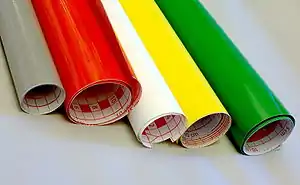
Self-adhesive plastic sheet, known in the United Kingdom as sticky-backed plastic, is wide plastic sheet or film with an adhesive layer on one side, used as a surface coating for decorative purposes. It is typically smooth and shiny, but can also come in textured varieties, in which case it can sometimes be used as a cheap alternative to veneer. The plastic is often PVC. The sheeting is typically sold with a removable paper release liner to prevent it from adhering prematurely.
Self-adhesive vinyl sheet was introduced to the UK market in the 1960s under the brand name Fablon.[1] It was extensively used in DIY at the time,[2] and notably featured in children's DIY projects on the British TV show Blue Peter, but always under the generic name "sticky-backed plastic."[3][4]
Smooth self-adhesive plastic sheet is typically used to cover the studio floor for shiny-floor shows, thus giving them their name.[5]
See also
References
- ↑ MacLeod, Heather (March 15, 2016). "Bringing it all back home – 1960′s interiors revisited". www.heathermacleod.co.uk. Retrieved 2016-08-05.
- ↑ Highmore, Ben (2014). The Great Indoors: At home in the modern British house. Profile Books. pp. 85. ISBN 9781847653468.
- ↑ "50 things we learned from Blue Peter". The Scotsman. 16 October 2008. Retrieved 2016-08-05.
"sticky-backed plastic" was the term used for the product marketed under the trade name Fablon
- ↑ Marson, Richard (4 October 2008). "Blue Peter: celebrating 50 years". Daily Telegraph. Retrieved 2016-08-09.
Blue Peter conjures up cosy memories of pets, badges and sticky-backed plastic
- ↑ Brook, Stephen (April 16, 2012). "Ten questions for Adrian Swift". The Australian. Retrieved 23 April 2016.